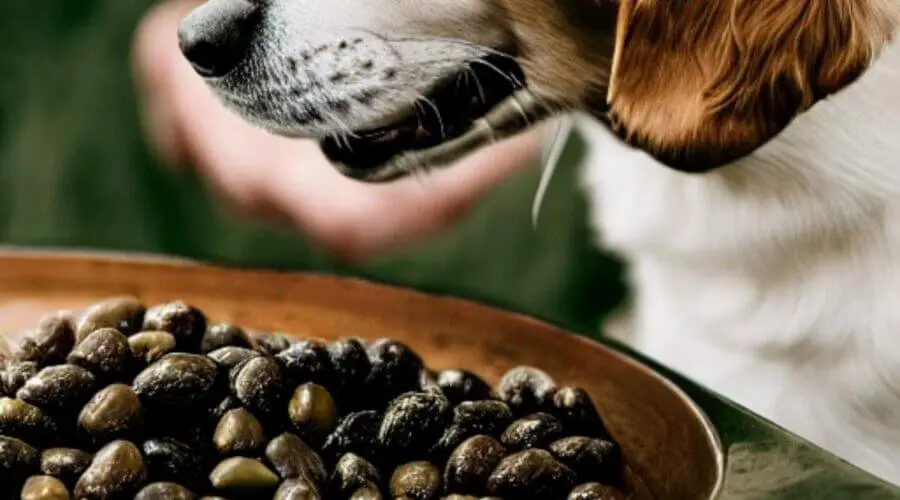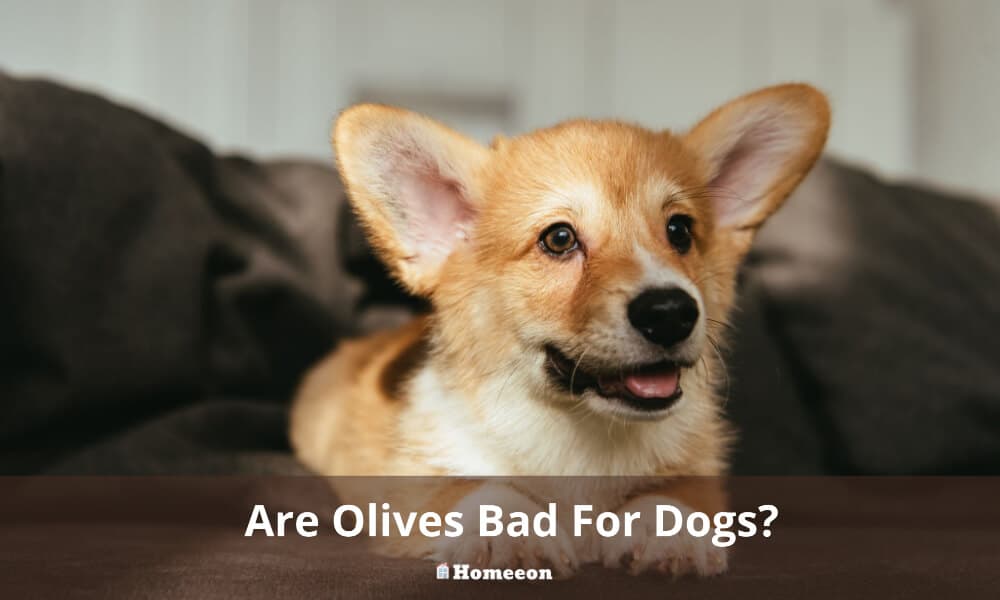Last Updated on August 15, 2023 By Emma W. Thomas
Yes, olives can be bad for dogs. While a few plain, pitted olives may not be harmful, they are high in fat and sodium. Excessive consumption can lead to digestive upset or sodium poisoning. It’s best to limit or avoid offering olives to your dog.
Are Olives Bad For Dogs?
For many pet owners, keeping their beloved furry friends healthy and safe is a top priority. We strive to provide them with nutritious and balanced diets, but sometimes questions arise about certain human foods and whether they are suitable for our canine companions. One such food that often invites curiosity is olives. So, are olives bad for dogs? Let’s explore five facts to shed some light on this topic.
1. Olives contain healthy fats, but…
Olives are a nutritional powerhouse for humans, rich in healthy monounsaturated fats and antioxidants. However, it’s important to note that dogs have different dietary requirements and digestive capacities compared to humans. While the healthy fats in olives may be beneficial to their human counterparts, it doesn’t necessarily mean the same holds true for dogs.
2. The sodium content may cause harm
Olives, particularly those that are brined or cured, tend to have a high sodium content. Consuming excessive amounts of sodium can lead to health issues in dogs, such as sodium ion poisoning. Symptoms may include increased thirst, vomiting, diarrhea, seizures, and even kidney damage. It’s vital to remember that even small amounts of olives can contribute to a dog’s overall sodium intake.
3. Pits pose a choking hazard
The pits found in olives can present a significant choking hazard for dogs, as they are hard and difficult to digest. Swallowing an olive pit could obstruct their airways or worst-case, lead to intestinal blockage if it gets stuck in their digestive system. To prevent any accidents, always remove the pits before considering giving olives to your furry friend, if at all.
4. Potential digestive issues
Dogs have sensitive digestive systems, and introducing new foods can sometimes lead to digestive upsets such as diarrhea or stomach discomfort. Olives may have acidic qualities that could upset your dog’s stomach or cause gastrointestinal distress. It’s essential to monitor their reactions and consult with a veterinarian if any adverse symptoms arise.
5. There are healthier alternatives
Instead of giving olives to your dog, there are numerous healthy alternatives that can still provide them with a delicious and nutritious treat. Options like carrots, green beans, or even small pieces of lean cooked meat can make excellent alternatives, granting a mix of chewy texture and positive health benefits. It’s always a good idea to consult with a veterinarian for specific recommendations tailored to your dog’s needs.
So Can Dogs Eat Olives?

Dogs can eat olives, but you need to exercise caution when feeding them. They don’t have toxic ingredients, but their pits may cause obstruction or choking in dogs. Although organic olives are highly-priced, they are the best option for your pet.
Remove the pit completely to avoid damaging your canine’s teeth and causing other digestive issues. Start with a tiny piece of olive and observe your pup for any unpleasant reactions such as a dog allergy.
If your canine eats too many olives, it may experience digestive issues such as stomach pain, upset, or diarrhea. You will need to consult your veterinarian immediately if the pet accidentally eats a lot of this fruit.
Avoid pickled or canned olives since they have high levels of sodium which is not good for dogs. A lot of salt will dehydrate a dog, and consuming a high amount of sodium for a long period will eventually lead to high blood pressure. Besides sodium, olives may contain additives and seasonings that are harmful to pets.
Ensure that you check for unsuitable ingredients such as feta cheese, anchovies, or blue cheese in stuffed olives before giving them to your pet.
How to Incorporate Olives into Your Dog’s Diet
Incorporating new ingredients into your dog’s diet can provide a variety of health benefits. Today, we’re going to explore an ingredient that might surprise you: olives! Rich in healthy fats, vitamins, and antioxidants, olives are a nutritious addition to your furry friend’s meals. However, it’s important to follow some guidelines to ensure your dog’s safety and well-being. Here are five tips on how to incorporate olives into your dog’s diet in a healthy and balanced way:
- Consult your veterinarian: Before introducing olives or any new food into your dog’s diet, it’s essential to consult with your veterinarian. They can provide personalized advice based on your dog’s specific needs and health conditions. Additionally, they can help you determine the appropriate serving size of olives for your four-legged companion.
- Choose the right type of olives: Not all olives are suitable for dogs. Opt for plain, pitted, and brine-cured olives without any added spices, oils, or seasonings. Avoid varieties such as garlic-stuffed or jalapeño-stuffed olives, as these may contain ingredients that could be harmful to your dog.
- Start with small portions: Begin by offering a small amount of olives as a treat or as a topping to your dog’s regular food. Monitor your dog closely for any signs of allergies or digestive issues. If everything goes well, you can gradually increase the amount over time.
- Chop or mash the olives: To make it easier for your dog to digest and avoid any choking hazards, consider chopping or mashing the olives before adding them to their meal. This also helps release the flavors and aromas, making the olives even more enticing for your canine companion.
- Incorporate olives into homemade treats: If you enjoy making homemade treats for your dog, consider including olives as an ingredient. You can find a variety of recipes online that use olives, such as olive-infused biscuits or frozen olive treats. Just ensure that the overall recipe remains balanced and doesn’t contain any other ingredients that may be harmful to dogs.
Remember, while olives can offer health benefits when incorporated into your dog’s diet, they should always be given in moderation. Here is a summary of the dos and don’ts of including olives in your dog’s diet:
| Do’s | Don’ts |
|---|---|
| Consult your veterinarian | Choose olives with added spices or oils |
| Start with small portions | Give whole olives without chopping or mashing |
| Chop or mash the olives | Overfeed with excessive amounts of olives |
| Incorporate olives into homemade treats | Share olives with pits, as they pose a choking hazard |
| Monitor your dog’s reaction | Ignore any signs of allergies or digestive issues |
What to Keep in Mind While Giving Olives to Your Dog
Your canines can eat olives, provided they are not harmful to them. However, you cannot feed your pet with olives for each meal or give them any of this fruit. The following aspects are worth keeping in mind;
- remove pit
- give fresh olives
- avoid flavoring
- Green and black olives
- Remove Pits
Unlike humans, dogs have no fine motor skills necessary to take out the pit from olives. Their paws are not adapted for that action, and they cannot remove any seeds. Since your pets can’t separate the pits, they will eat the whole olive and risk getting choked. If they chew it, their teeth may also be affected.
Make sure that your olives have no pits before feeding your dogs.
2. Give fresh olives
Your canine’s health is very vital. It would help if you avoided old olives, those with mold, or coloration. Please do not give your pets any spoilt or contaminated food, as this will affect their health. Since it is hard to get fresh olives throughout the year, avoid giving them to your pets. Never give them canned or spiced foods.
3. Avoid flavoring
Unlike humans, dogs can’t process flavor, and their taste buds can’t notice the difference in different tastes. Flavored olives also contain sodium, which is bad for canines as they can’t process flavors and salt.
Choose plain olives for your pet available in fruits and vegetable aisles. If plain olives are not available, avoid canned ones or those that come with some topping.
4. Green and Black Olives
There are two types of olives, namely black and green, and you need to know which ones are suitable for your pet. Both kinds of olives are the same in terms of nutritional content, and the only difference is that green olives are raw while black ones are ripened.
Your dog can eat any of these fruits, but remember no salt or spices.
How Many Olives Should I Give My Pup?
You already know that it is fine to feed your canine with olives. However, there’s a need to know how many to give at a time. If it is the first time to provide your pet with the fruits, start with a small bit and observe its reaction. Your dog may or may not like trying new foods depending on its personality.
You can start with one olive a day and wait for at least 24 hours to see any unpleasant effects. If your pup seems okay, you can increase the amount to two and be on the lookout for any undesirable reaction.
If your dog shows no adverse reactions after eating the olives, you can feed it with them, but not daily. You can occasionally give your pets the fruits but not more than two at a time.
Never give your dog a full bowl of olives since they contain high amounts of saturated fat. Your dog’s pancreas and kidneys cannot handle high levels of fat. If you expose them to food with high-fat content, they risk developing pancreatitis, a life-threatening illness.
Pancreatitis causes inflammation of the pancreas, which may require urgent surgery. Ensure that your pet’s diet contains 95% of quality dog food before experimenting with human food.
Health Benefits of Olives to Dogs
When given in moderation, olives have some health benefits for your dogs that include;
- Healthy antioxidants such as proteins, Calcium, and vitamins A, E, and K
- Source of oleate (an essential fat that promotes cognitive functions and heart health)
- Improved circulation
- Healthy skin and coat
- Decreased cholesterol and weight loss
- Supports the immune system and prevents cancer
- Improved digestion
Can Dogs Eat Olives with Pimentos?
Yes, it is okay for dogs to eat green olives with pimentos if they are the only things stuffed in them. Some green olives may contain other substances besides pimentos such as garlic, oils, cheeses, onions, and other additives that are not healthy for your dog. Check the label for ingredients.

Conclusion
Olives are not bad for dogs since they can provide a lot of health benefits. However, it is advisable to feed them sparingly since your canine’s digestive system is not adapted to handle the high-fat levels contained in olives. Opt for fresh olives always but avoid salt and flavors.
References:
https://texashillcountryoliveco.com/blogs/news/can-dogs-eat-olives-the-health-benefits-risks-explained
https://www.rover.com/blog/can-my-dog-eat-olives/
Emma is a graduate of Domestic Science or Family and Consumer Sciences (Home Economics) from the University of Wisconsin. She has 7 years of experience Working with the strategic section of BestBuy and now writing full-time for Homeeon.
From Managing the Home, Interiors, Cleaning, and Exteriors to Gardening and everything about Making A Home Liveable – is her passion and this Homeeon is the result of this.
Emma loves decorating her home with the best stuff found online. She cares about quality over anything and writes reviews about them here in Homeeon. Get in touch with her over Pinterest.
Keep reading her blogs.

